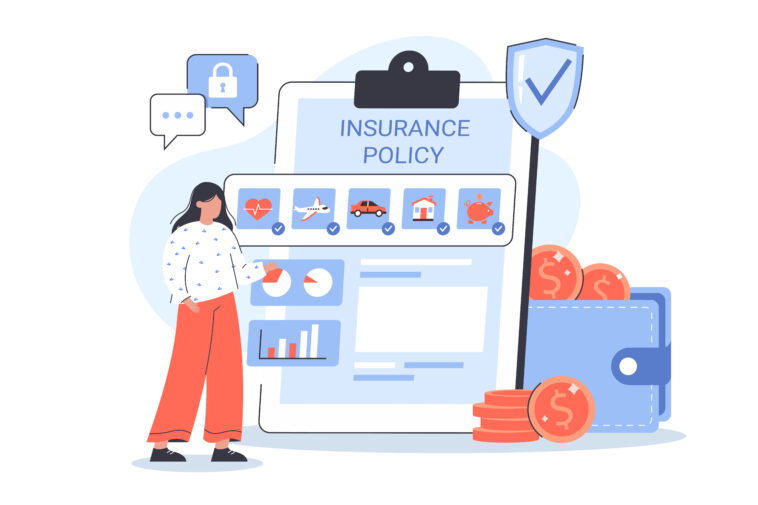Insurance is an essential part of financial planning. Whether it’s protecting your health, home, car, or even your life, **insurance plans** provide a safety net to help you manage risks and recover from unexpected events. With so many different types of insurance available, it can be challenging to determine which plans are right for you.
This comprehensive guide will walk you through the most common types of insurance plans, how they work, and what factors to consider when choosing coverage. Whether you’re buying insurance for the first time or reviewing your current policies, this guide will help you make informed decisions and find the best protection for your needs.
What is Insurance?
**Insurance** is a contract in which an individual or entity (the insured) receives financial protection or reimbursement against losses from an insurance company (the insurer). In exchange for regular payments (called premiums), the insurer agrees to cover certain risks, such as damage to property, illness, or loss of income, based on the terms of the insurance policy.
The primary purpose of insurance is to transfer the risk of financial loss from the individual to the insurer, providing peace of mind and financial stability in the face of unexpected events. Depending on the type of insurance, policies can cover everything from medical expenses to property damage, theft, accidents, and more.
Types of Insurance Plans
There are various types of insurance plans designed to cover different aspects of life and assets. Here’s a breakdown of the most common types of insurance you should know about:
1. Health Insurance
**Health insurance** is one of the most important types of insurance, as it helps cover the cost of medical expenses, including doctor visits, hospital stays, surgeries, and prescription medications. Without health insurance, even minor medical treatments can be financially overwhelming.
There are several different health insurance options, including employer-sponsored plans, government programs, and individual plans purchased through insurance marketplaces.
Types of Health Insurance Plans:
- HMO (Health Maintenance Organization): Requires you to choose a primary care physician (PCP) and get referrals to see specialists. Typically has lower premiums but less flexibility in choosing providers.
- PPO (Preferred Provider Organization): Offers more flexibility in choosing healthcare providers and specialists without needing referrals. Higher premiums but greater access to doctors.
- EPO (Exclusive Provider Organization): Similar to PPOs, but coverage is limited to in-network providers, except in emergencies.
- HDHP (High Deductible Health Plan): Features lower premiums but higher deductibles. Often paired with Health Savings Accounts (HSAs) to help cover out-of-pocket expenses.
Key Considerations for Health Insurance:
- Premium costs and deductibles
- Network of doctors and hospitals
- Prescription drug coverage
- Preventive care and wellness services
2. Life Insurance
**Life insurance** provides financial protection to your loved ones in the event of your death. It ensures that your beneficiaries receive a death benefit (a lump sum payout) to help cover expenses such as funeral costs, debts, or ongoing living expenses. There are two main types of life insurance: **term life insurance** and **permanent life insurance**.
Types of Life Insurance:
- Term Life Insurance: Provides coverage for a specific period (e.g., 10, 20, or 30 years). It’s typically more affordable but does not build cash value.
- Whole Life Insurance: A type of permanent life insurance that provides lifelong coverage and accumulates cash value over time. Premiums are higher than term life insurance.
- Universal Life Insurance: Another form of permanent life insurance with flexible premiums and the potential to build cash value based on market performance.
Key Considerations for Life Insurance:
- Coverage amount (based on your family’s financial needs)
- Term length (for term life insurance)
- Premium costs
- Potential for cash value growth (for whole or universal life insurance)
3. Auto Insurance
**Auto insurance** provides financial protection in the event of a car accident, theft, or damage to your vehicle. Most states require drivers to have a minimum level of auto insurance coverage. Auto insurance policies typically include a combination of liability coverage, collision coverage, and comprehensive coverage.
Types of Auto Insurance Coverage:
- Liability Coverage: Covers the cost of damage or injury you cause to others in an accident. It’s required in most states.
- Collision Coverage: Pays for damage to your vehicle resulting from a collision with another vehicle or object.
- Comprehensive Coverage: Covers non-collision-related damage to your vehicle, such as theft, fire, or natural disasters.
- Uninsured/Underinsured Motorist Coverage: Protects you if you’re in an accident with a driver who doesn’t have sufficient insurance.
Key Considerations for Auto Insurance:
- State-required minimum coverage levels
- Deductibles and premium costs
- Discounts for safe driving, bundling policies, or using telematics
- Optional coverage, such as roadside assistance
4. Homeowners Insurance
**Homeowners insurance** protects your home and personal property against damage or loss due to events like fire, theft, or natural disasters. It also provides liability coverage if someone is injured on your property. Most mortgage lenders require homeowners to have insurance as part of the loan agreement.
Types of Homeowners Insurance Coverage:
- Dwelling Coverage: Covers damage to the structure of your home caused by covered perils like fire, storms, or vandalism.
- Personal Property Coverage: Protects your belongings (e.g., furniture, electronics, clothing) from theft or damage.
- Liability Coverage: Covers legal costs and damages if someone is injured on your property.
- Additional Living Expenses (ALE): Pays for temporary living costs if your home becomes uninhabitable due to a covered event.
Key Considerations for Homeowners Insurance:
- Replacement cost vs. actual cash value coverage
- Coverage limits for high-value items like jewelry
- Flood or earthquake coverage (typically not included in standard policies)
- Discounts for security systems or home improvements
5. Renters Insurance
**Renters insurance** is designed for people who rent their homes or apartments. While your landlord’s insurance covers the building itself, renters insurance protects your personal belongings and provides liability coverage in case of accidents. It’s an affordable way to protect your possessions from theft, fire, or other hazards.
Types of Renters Insurance Coverage:
- Personal Property Coverage: Protects your personal belongings from damage or theft.
- Liability Coverage: Covers legal costs if someone is injured in your rented home or apartment.
- Additional Living Expenses (ALE): Covers the cost of temporary housing if your rental becomes uninhabitable.
Key Considerations for Renters Insurance:
- Coverage for high-value items (e.g., electronics, jewelry)
- Deductibles and premium costs
- Optional coverage for natural disasters (e.g., earthquakes, floods)
6. Disability Insurance
**Disability insurance** provides income protection if you become unable to work due to an injury or illness. This type of insurance ensures that you can continue to meet your financial obligations, such as paying for rent or mortgages, groceries, and other living expenses, while you recover.
Types of Disability Insurance:
- Short-Term Disability (STD): Provides temporary income replacement for a few months (typically 3 to 6 months) after a disabling event.
- Long-Term Disability (LTD): Provides income replacement for an extended period, often until retirement age, depending on the policy.
Key Considerations for Disability Insurance:
- Waiting period before benefits begin (typically 30 to 90 days)
- Percentage of income replaced (usually 50% to 70%)
- Definition of disability (e.g., own occupation vs. any occupation)
7. Travel Insurance
**Travel insurance** offers protection against financial losses or emergencies that may occur while traveling, such as trip cancellations, medical emergencies, lost luggage, or flight delays. It’s especially important for international trips or expensive vacations where unexpected events can result in significant costs.
Types of Travel Insurance Coverage:
- Trip Cancellation/Interruption Coverage: Reimburses you for non-refundable expenses if your trip is canceled or cut short due to covered reasons like illness or weather.
- Medical Coverage: Covers medical expenses and emergency medical evacuation while traveling abroad.
- Lost Luggage Coverage: Reimburses you for lost, damaged, or stolen luggage and personal items.
Key Considerations for Travel Insurance:
- Coverage limits for medical emergencies abroad
- Pre-existing medical condition exclusions
- Coverage for trip delays or interruptions
- Optional coverage for adventure activities (e.g., skiing, scuba diving)
How to Choose the Right Insurance Plan
With so many insurance options available, selecting the right plan can feel overwhelming. However, by considering your unique needs and financial situation, you can find coverage that offers the protection you need. Here are some key steps to help you choose the right insurance plan:
1. Assess Your Needs
Start by identifying your specific risks and priorities. For example, if you have dependents, life insurance might be a priority. If you drive frequently, auto insurance will be essential. List the types of coverage you need and the risks you want to mitigate.
2. Compare Policies
Once you’ve identified your needs, compare different policies and providers to find the best coverage. Look at factors like premium costs, deductibles, coverage limits, and exclusions. Don’t forget to consider customer service and the insurer’s reputation when making your decision.
3. Consider Bundling Options
Many insurance companies offer discounts if you bundle multiple policies, such as home and auto insurance. Bundling can simplify your coverage and save you money on premiums.
4. Review and Update Regularly
Life circumstances change, and so should your insurance. Review your policies annually to ensure they still meet your needs. If you experience a major life event—like getting married, having a child, or buying a home—it may be time to adjust your coverage.
Conclusion: Protecting What Matters Most
Insurance plays a critical role in safeguarding your financial well-being and protecting you from unexpected events. By understanding the different types of insurance plans and how they work, you can make informed decisions that provide peace of mind and security for you and your loved ones.
Whether you’re looking for health coverage, securing your home, or planning for the future with life insurance, the right insurance plan can help you navigate life’s uncertainties with confidence.
Frequently Asked Questions (FAQs)
Is it necessary to have multiple types of insurance?
Yes, depending on your situation, you may need multiple types of insurance to cover different areas of your life. For example, you might have health insurance to cover medical expenses, auto insurance to protect your vehicle, and life insurance to provide for your family in case of death.
How much life insurance coverage do I need?
A common rule of thumb is to have life insurance coverage that is 10 to 12 times your annual income. However, the right amount depends on factors such as your debts, living expenses, and the financial needs of your dependents.
Can I switch insurance providers if I find a better rate?
Yes, you can switch insurance providers if you find a better rate or better coverage. Be sure to compare policies thoroughly and avoid any gaps in coverage during the transition. Additionally, check for cancellation fees or policy terms before making the switch.
Looking to explore your insurance options? By understanding your needs and the types of insurance available, you can make sure you’re well-protected in any situation.

